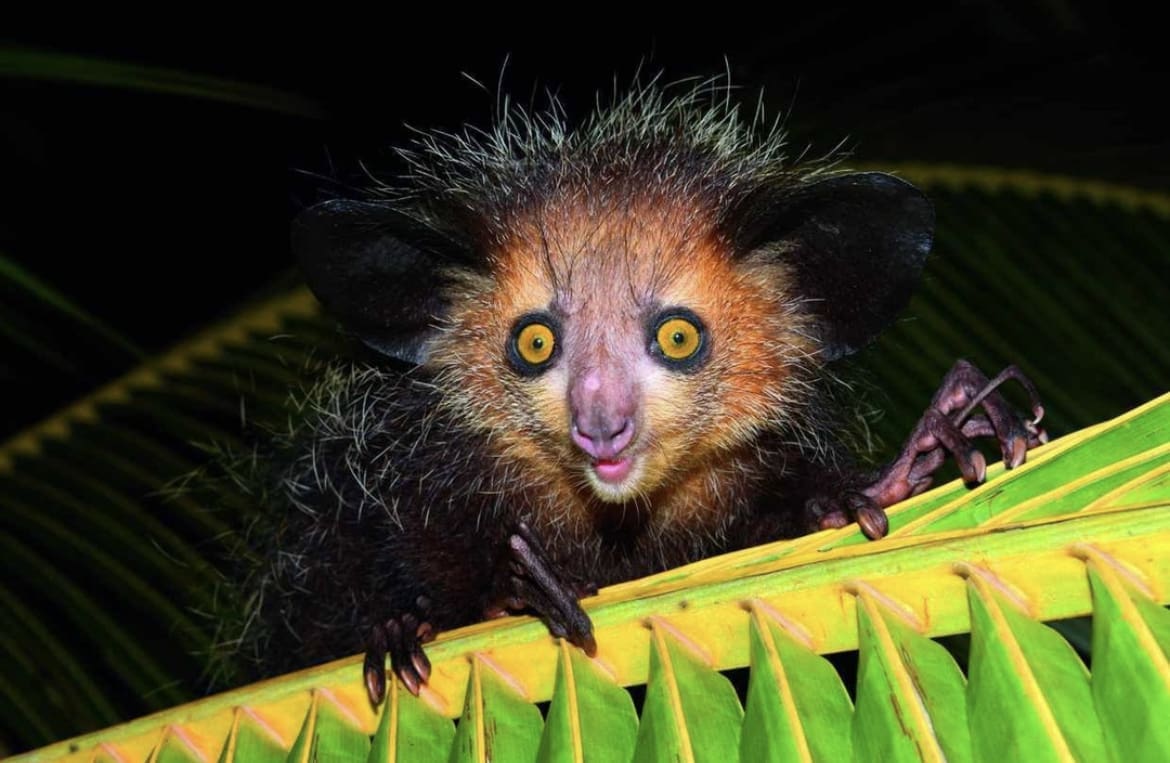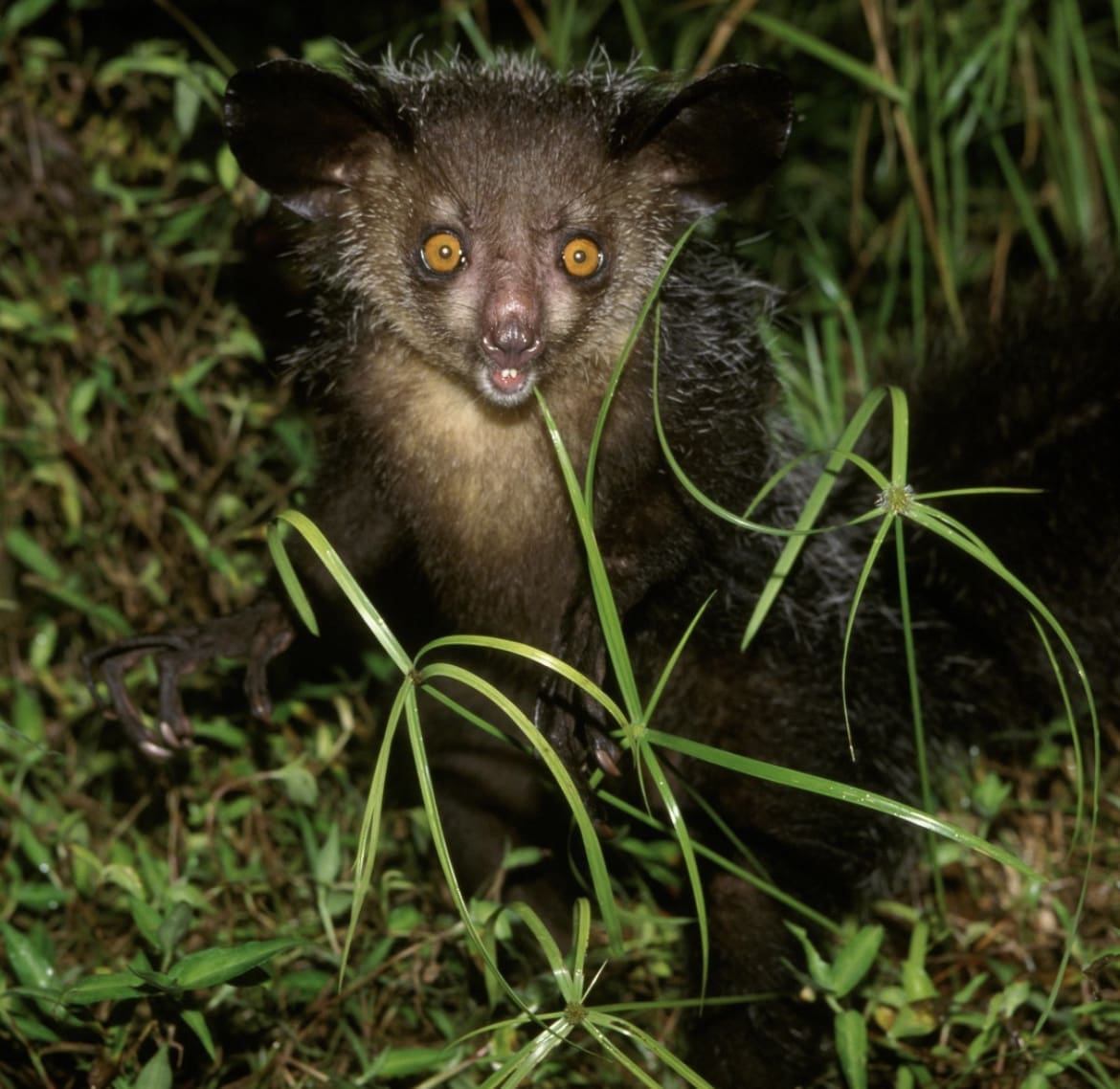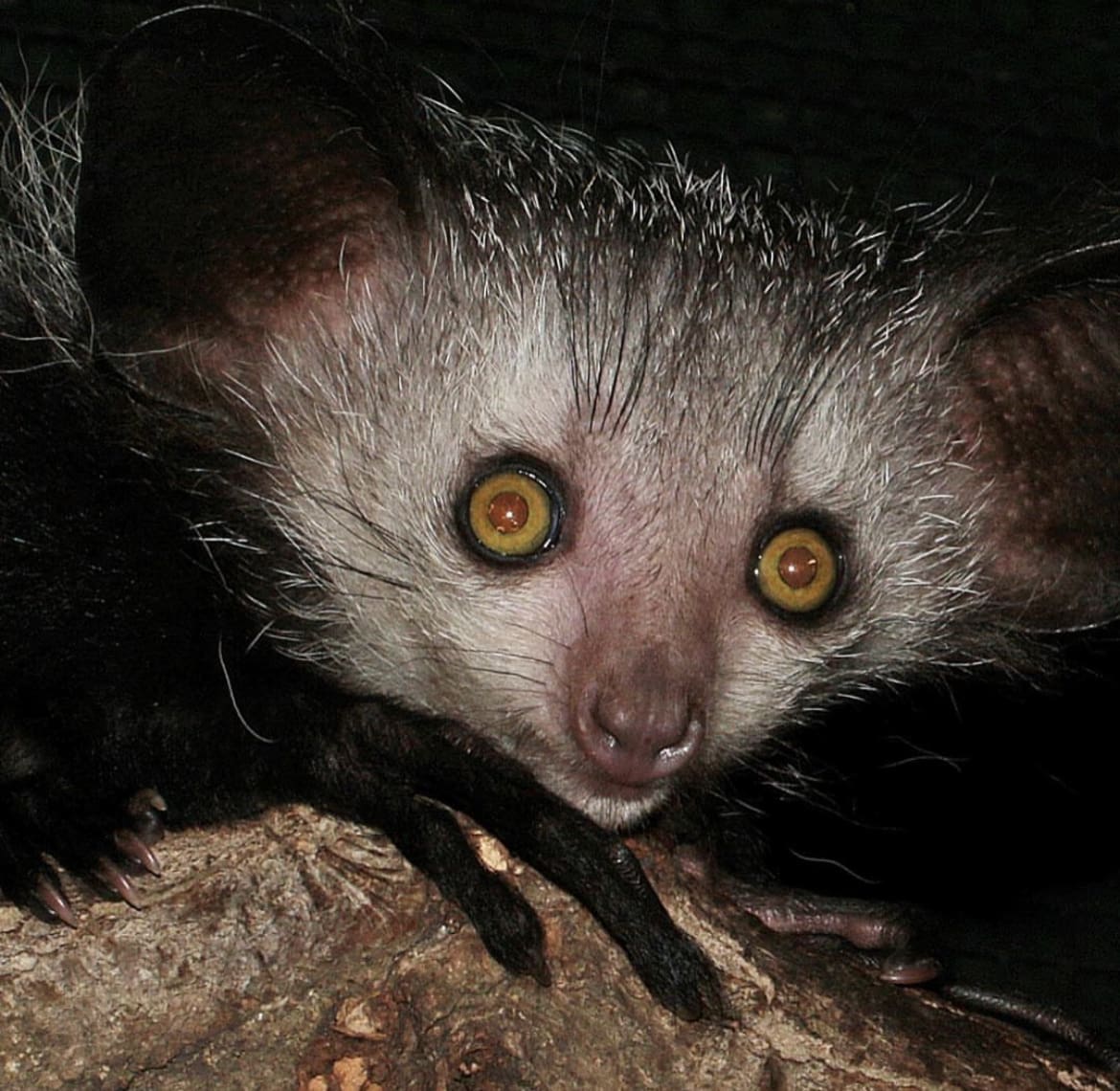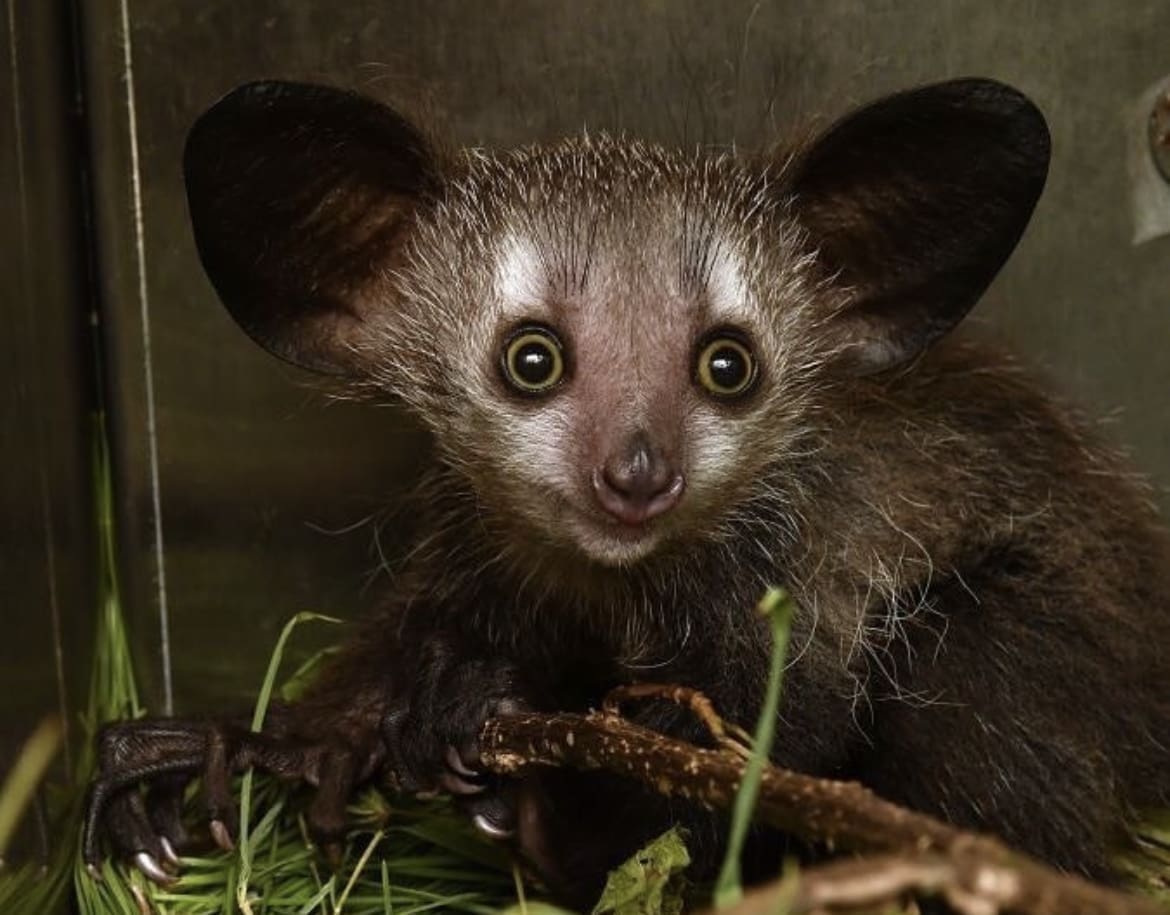Alright, folks, let’s dive into the world of one of the most bizarre creatures you’ve probably never heard of – the Aye Aye. This little critter is not your typical cute and cuddly pet material; it’s more like the punk rocker of the animal kingdom, with its unconventional looks and nocturnal antics.
What is the Aye-Aye?
Native exclusively to Madagascar, the Aye Aye has the scientific community scratching their heads about where exactly it fits on the family tree. It’s a lemur, but not just any lemur. It’s like the black sheep of the lemur family, standing out with its unique features and behaviors.
Now, before you start thinking this is just another boring biology lesson, let me tell you, the Aye Aye is a creature that defies expectations. It’s a symbol of Madagascar’s incredible biodiversity and a testament to the island’s evolutionary quirks. So, if you’re into discovering the oddballs of the animal world, the Aye Aye is a goldmine.
What do Aye-Ayes look like?
Imagine a creature that looks like it’s been assembled from parts of several different animals. Got it? Well, you’re probably picturing something close to an Aye Aye. These guys have bushy tails that could rival any squirrel’s, massive ears that look like they’ve been borrowed from a bat, and a face that’s…well, let’s just say it’s got character.
But the real showstopper is the Aye Aye’s hands, especially its middle finger. Thin, elongated, and downright eerie, this finger looks like it belongs in a horror movie. It’s not just for show, though – more on that later. And their eyes? Big, bright, and reflective, these peepers are perfect for spotting dinner in the dead of night. So, while they might not win any beauty contests in the traditional sense, Aye Ayes are fascinatingly adapted to their unique lifestyle.

How big are Aye-Ayes?
When it comes to size, Aye Ayes are on the larger side for nocturnal primates but wouldn’t exactly tip the scales. On average, they’re about the length of a large house cat, but with much of that length coming from their bushy tails. Weighing in at around 2 to 2.5 kg (4 to 5.5 lbs), they’re substantial enough to be impressive but still light enough to navigate the treetops with ease.
Aye-Aye Fur
Moving on from their size, let’s talk about one of the Aye Aye’s most noticeable features: its fur. If you’re picturing something soft and cuddly, you might be a bit off the mark. The Aye Aye’s coat is more on the coarse side, meant more for function than fashion. It ranges from dark brown to black, with a sprinkling of white or silver hairs that give it a slightly grizzled look. This isn’t just about aesthetics, though; their fur is perfectly adapted to their nocturnal and arboreal life, providing camouflage among the trees and protection from the elements.
And here’s a fun fact: the Aye Aye’s bushy tail, which is longer than its body, isn’t just for show. It acts as a kind of all-weather gear, wrapping around the body for warmth during those chilly Madagascar nights or fluffing out as a signal when the Aye Aye feels threatened or wants to assert its dominance. Talk about versatile fashion!
Aye Aye Teeth
But wait, there’s more to the Aye Aye than just its funky fur and tail. Let’s talk teeth. The Aye Aye’s chompers are something else. Unlike other primates, its incisors grow continuously, much like those of a rodent. This might sound weird, but it’s a key adaptation for its unique diet (hang tight; we’ll get to that). These ever-growing front teeth allow the Aye Aye to gnaw through tough outer shells of nuts and insects’ cocoons. So, while their dental situation might make an orthodontist wince, it’s perfect for their lifestyle.
Aye Aye Finger
Now, onto the main attraction: the Aye Aye’s infamous middle finger. If you thought the rest of the Aye Aye was odd, this slender, skeletal digit takes the cake. It’s long, it’s thin, and it’s incredibly versatile. Primarily, this finger is a tool for foraging. The Aye Aye taps on wood with its other, more robust fingers and listens with its large ears for the echo that indicates hollow spaces where bugs might be lurking. Then, it uses that creepy-cool middle finger to fish out grubs and insects from the wood. Think of it as nature’s own version of a Swiss Army knife.
But it’s not just for feeding. This finger also has a role in grooming and perhaps even in social interactions among Aye Ayes. It’s a prime example of how evolution can go down some pretty quirky paths when left to its own devices on an isolated island like Madagascar.

Aye-Aye Eyes
Delving deeper into the peculiar world of the Aye Aye brings us to their captivating eyes. Oversized and luminous, these orbs are the windows to the Aye Aye’s nocturnal soul, glowing eerily when caught in the light. Adapted to life under the cover of darkness, their eyes are large to capture as much moonlight as possible, allowing them to see in conditions that would leave us humans groping blindly. This exceptional night vision facilitates their unique foraging habits and keeps them alert to predators lurking in the shadows. It’s a mesmerizing feature that adds to the Aye Aye’s mysterious allure, proving that beauty truly is in the eye of the beholder.
Aye-Aye Colouration
The Aye Aye’s coloration is as distinctive as its lifestyle. Its fur, a mix of black, brown, and occasionally with a hint of silver or white, isn’t just about making a fashion statement in the animal kingdom. This mottled coat serves as excellent camouflage, blending seamlessly into the dark canopy of Madagascar’s forests. It’s a crucial adaptation for an animal that spends most of its life in the trees, allowing it to remain nearly invisible to predators and prey alike. The varying shades across its body and limbs also help break up its outline, making the Aye Aye a master of stealth. So, while its coloration may not win it any beauty contests, it’s a vital part of the Aye Aye’s survival kit, proving once again that in nature, function often trumps form.
What do Aye-Ayes eat?
Now, let’s get to the juicy part – or should I say, the buggy part? The Aye Aye’s diet is as unusual as the rest of its characteristics. These creatures are the animal kingdom’s answer to a lock-picking kit, specializing in extracting hard-to-reach food sources with their unique set of tools. Primarily, Aye Ayes feast on insects and grubs, using their elongated middle finger to fish these critters out of tree bark or bamboo. But their diet isn’t limited to just bug sushi; they also have a taste for fruit, nectar, and fungi.
This eclectic menu makes the Aye Aye a vital part of Madagascar’s ecosystem, acting as both pest control and seed disperser. Their preference for certain types of nectar and fruit even helps with the pollination of some plant species. So, while their feeding habits might seem a bit odd to us, they play a crucial role in maintaining the health and diversity of their habitat. It’s a perfect example of how every creature, no matter how strange, has its place in the web of life.

Social Structure
Diving into the social world of the Aye Aye reveals a creature that values its personal space. Unlike the social butterflies of the animal kingdom, Aye Ayes are the introverts, preferring solitude over company. These nocturnal primates are mostly solitary creatures, coming together only for breeding purposes. Their social structure is loosely organized, with individuals having overlapping home ranges that they defend vigorously from others of the same sex.
Communication among Aye Ayes involves a mix of vocalizations, body postures, and even scent marking to convey messages across the treetops. These signals help maintain their solitary lifestyles, allowing them to come together when necessary but otherwise live independently. This preference for solitude is not just a quirky trait but a reflection of their specialized feeding habits, which require a large foraging area to support their diet. In the dense forests of Madagascar, the Aye Aye whispers its secrets, a solitary guardian of the night.
How do Aye-Ayes reproduce?
When it comes to matters of the heart, Aye Ayes are decidedly low-key. Their mating system is polygynous, meaning males may mate with multiple females when the opportunity arises. However, encounters between potential mates are rare, given their solitary nature and the vastness of their territories. When they do meet, courtship is a subtle affair, with much of the interaction focused on gentle pursuits and vocal communications.
Female Aye Ayes have a gestation period of about five months, after which they give birth to a single offspring. The young Aye Aye is weaned and begins to explore solid foods around two months but remains dependent on its mother for up to two years. This extended care period is crucial for the young Aye Aye to learn the complex skills needed for survival, from foraging techniques to navigating the treetops. The bond between mother and offspring is a testament to the Aye Aye’s intricate life, hidden away in the heart of Madagascar’s forests.
How long do Aye-Ayes live?
In the wild, the lifespan of an Aye Aye can be quite variable, but they are known to live for up to 20 years or more under the right conditions. In captivity, where threats are minimized, and nutrition is consistent, Aye Ayes have been known to reach ages of over 30 years. This longevity is remarkable for a creature of its size and is a testament to the Aye Aye’s adaptability and resilience.
However, life in the wild is fraught with challenges, from finding enough food to avoiding predators and human threats. The Aye Aye’s long lifespan allows it multiple breeding opportunities over the years, a crucial factor for the survival of this rare species. Each year in the life of an Aye Aye is a victory against the odds, a silent testament to the enduring spirit of Madagascar’s most mysterious resident.

Is the Aye-Aye dangerous?
Let’s debunk one of the biggest myths right off the bat: despite its somewhat ghoulish appearance and nocturnal habits, the Aye Aye is far from dangerous to humans. In fact, it’s quite the opposite. These creatures are incredibly shy and will do their best to avoid human contact. The folklore surrounding them, however, paints a different picture, often depicting Aye Ayes as omens of bad luck or even harbingers of death. This unfortunate reputation has contributed to the persecution of Aye Ayes by locals in some areas of Madagascar, driven by fear and misunderstanding.
Scientifically speaking, Aye Ayes pose no threat. They’re not aggressive unless cornered or captured, and their diet is primarily focused on insects and fruit. The biggest danger they pose is to the larvae of wood-boring insects. So, if you’re not a grub hiding in a tree, you’re probably safe. It’s time we look past the superstitions and appreciate the Aye Aye for the unique and fascinating creature it is, not the mythical monster it’s been made out to be.
Are Aye-Ayes territorial?
Indeed, Aye Ayes are quite territorial, especially when it comes to their feeding grounds. Given their specialized diet, they require large areas of forest to provide enough food, which means they’re not too keen on sharing. Males have larger territories that may overlap with those of several females, and they spend a significant amount of time patrolling and marking their territory with scent. This territorial behavior ensures that they have exclusive access to the resources within their domain, critical for their survival.
Despite their solitary nature, Aye Ayes maintain a complex network of territories that intersect and overlap, allowing for the necessary interaction during mating seasons. These territories are not just random patches of forest but carefully chosen areas that offer the best opportunities for foraging and nesting. So, while they may not be social butterflies, Aye Ayes have a deep connection to their home turf, defending it with surprising vigor against intruders.
How fast are Aye-Ayes?
When it comes to speed, Aye Ayes are not the sprinters of the animal kingdom. Their movement is more deliberate, adapted to their nocturnal lifestyle and arboreal habitat. In the dense forests of Madagascar, agility and precision are more valuable than speed. Aye Ayes navigate the treetops with a slow, methodical grace, using their long fingers to probe for food and their large eyes to scan for danger.
However, don’t let their slow pace fool you. When threatened, Aye Ayes can make a quick getaway, leaping from branch to branch with surprising agility. Their movement through the trees is a blend of creeping and climbing, carefully calculated to avoid drawing attention. So, while they might not win any races, Aye Ayes are perfectly tuned to the rhythms of the forest, moving at a pace that keeps them safe and well-fed.

Where do Aye-Ayes live?
Aye Ayes call the lush and diverse forests of Madagascar their home, showcasing a remarkable adaptability to various habitats across the island. From the rain-drenched northern forests to the dry deciduous regions in the west and the bamboo groves of the east, Aye Ayes make themselves comfortable wherever there’s wood to be gnawed and insects to feast on. Their presence across such varied environments highlights not just the Aye Aye’s versatility but also the richness of Madagascar’s ecosystems.
These solitary creatures are masters of their realm, weaving through the treetops in the cover of night. The dense canopies of Madagascar offer more than just shelter and food; they provide a secluded haven far from human disturbances. However, the encroachment of civilization and the clearing of forests for agriculture are shrinking these habitats, pushing the Aye Aye into increasingly isolated patches of wilderness.
How many Aye-Ayes are there in the wild?
Quantifying the Aye Aye population is a challenging task, thanks to their elusive nature and the dense habitats they prefer. Estimates vary, but the consensus among conservationists is that their numbers are declining. The exact count of Aye Ayes in the wild remains a mystery, a reflection of the difficulties in studying these nocturnal creatures. Researchers rely on indirect methods, such as sightings, nest counts, and acoustic monitoring, to gauge their population density and distribution.
What is clear, however, is that the Aye Aye is under threat. Habitat destruction, hunting, and persecution due to local superstitions are the primary culprits behind their dwindling numbers. Conservation efforts are in place, aiming to protect the Aye Aye’s habitat and educate local populations about the vital role these animals play in the ecosystem. The survival of the Aye Aye is a crucial indicator of the health of Madagascar’s forests, making their protection a priority for conservationists worldwide.
Are Aye-Ayes endangered?
Yes, the Aye Aye is classified as Endangered on the IUCN Red List of Threatened Species. This status underscores the urgent need for conservation efforts to ensure their survival. Despite their adaptability to different forest environments, Aye Ayes cannot escape the widespread threats of deforestation, habitat fragmentation, and human superstition that lead to direct persecution.
The endangered status of the Aye Aye serves as a rallying cry for conservationists and wildlife enthusiasts. It emphasizes the importance of preserving Madagascar’s unique biodiversity, not just for the Aye Aye but for all species that share its habitat. Protecting the Aye Aye involves a combination of habitat conservation, research, and community-based initiatives to mitigate human-wildlife conflict. The fight to save the Aye Aye is a fight for the heart of Madagascar itself, a battle against the clock to save one of the planet’s most extraordinary creatures before it’s too late.
Threats to Aye Ayes in the Wild
The Aye Aye faces a gauntlet of threats in its fight for survival, each one a piece of the puzzle that puts this unique species at risk. Habitat destruction is the heavyweight contender, with vast swathes of Madagascar’s forests being cleared for agriculture, logging, and development. This not only reduces the Aye Aye’s living space but fragments it, isolating populations and making it harder for these solitary creatures to find mates and food.
But the challenges don’t stop there. Hunting, fueled by local superstitions that cast Aye Ayes as harbingers of bad luck, adds another layer of danger. Though not targeted for bushmeat or the pet trade like other animals, Aye Ayes are often killed on sight out of fear. Additionally, climate change looms as a burgeoning threat, altering the delicate balance of their forest habitats and potentially disrupting the availability of their food sources.
Where to See Aye-Ayes In the Wild
For the intrepid wildlife enthusiast, Madagascar offers the unique opportunity to spot an Aye Aye in its natural habitat. However, patience and respect for these creatures’ nocturnal lifestyle are paramount. The Palmarium Reserve, also known as Ankanin’ny Nofy (Nest of Dreams), on the east coast of Madagascar, is one of the few places where Aye Ayes can be seen relatively easily, thanks to conservation efforts that protect a semi-wild population.
Eco-tourism, when conducted responsibly, can contribute to the conservation of the Aye Aye, offering a sustainable way for locals to value and protect their natural heritage. Visitors are encouraged to employ local guides, whose expertise and knowledge not only enhance the chance of an encounter but ensure minimal disturbance to the animals.
Tips for Spotting Aye Ayes
Seeing an Aye Aye in the wild is a rare privilege, requiring a bit of know-how:
- Go at night: Aye Ayes are nocturnal, so your best chance of spotting one is after dark.
- Stay quiet: Noise can scare them away, so move silently and keep chatter to a minimum.
- Use red light: If using a flashlight, cover it with red cellophane. Aye Ayes are less sensitive to red light, so it’s less likely to disturb them.
- Be patient: Wildlife watching is a waiting game. Stay in one spot and keep your eyes peeled.
Facts about The Aye Aye
- Aye Ayes are the world’s largest nocturnal primate.
- They have a unique method of finding food called percussive foraging, where they tap on wood to listen for insects moving inside.
- Aye Ayes have a special membrane over their third eyelid, known as a nictitating membrane, which helps protect their eyes while foraging.
- Unlike most primates, Aye Ayes have continuously growing incisors.
- They can rotate their third finger up to 360 degrees to extract food.
Myths about The Aye Aye
- Harbinger of death: In some Malagasy cultures, seeing an Aye Aye is considered an omen of death. This myth has contributed to their persecution.
- Human reincarnation: Some believe Aye Ayes are the reincarnated spirits of ancestors, adding to their mystique.
- Curses: There’s a myth that if an Aye Aye points its middle finger at you, you’re cursed. Fortunately, this is just a tall tale.
